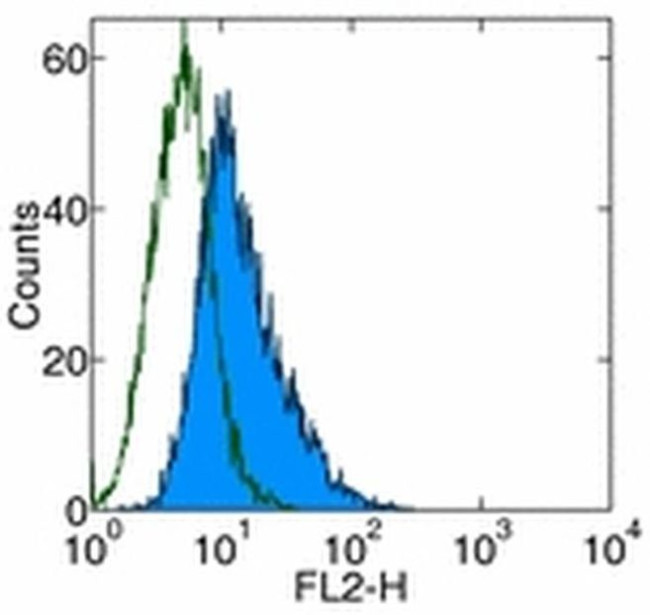Search Thermo Fisher Scientific
Product Details
12-6603-42
Species Reactivity
Published species
Host/Isotype
Recommended Isotype Control
Class
Type
Clone
Conjugate
Excitation/Emission Max
Form
Concentration
Purification
Storage buffer
Contains
Storage conditions
Shipping conditions
RRID
Product Specific Information
Description: The JD3 monoclonal antibody reacts with human DR3, also known as Apo-3, WSL-1, TRAMP, LARD, DDR3, and TR3. DR3, a novel death receptor is expressed at low level by monocytes and granulocytes. Interaction of DR3 with its ligand activates NF-kappa B pathway and induces apoptosis. Initially, DR3 was thought to be a receptor for TWEAK, but further studies have shown that TWEAK could induce apoptosis via receptors distinct from DR3. JD3 has been reported for use in flow cytometric analysis.
Applications Reported: The JD3 antibody has been reported for use in flow cytometric analysis.
Applications Tested: This JD3 antibody has been pre-titrated and tested by flow cytometric analysis of normal human peripheral blood cells and human DR3-transfected cells. This can be used at 5 µL (0.125 µg) per test. A test is defined as the amount (µg) of antibody that will stain a cell sample in a final volume of 100 µL. Cell number should be determined empirically but can range from 10^5 to 10^8 cells/test.
Excitation: 488-561 nm; Emission: 578 nm; Laser: Blue Laser, Green Laser, Yellow-Green Laser.
Filtration: 0.2 µm post-manufacturing filtered.
Target Information
DR3/TNFRSF25 is a member of the TNF-receptor superfamily. This receptor is expressed preferentially in the tissues enriched in lymphocytes, and it may play a role in regulating lymphocyte homeostasis. This receptor has been shown to stimulate NF-kappa B activity and regulate cell apoptosis. The signal transduction of this receptor is mediated by various death domain containing adaptor proteins. Knockout studies in mice suggested the role of DR3/TNFRSF25 in the removal of self-reactive T cells in the thymus. Multiple alternatively spliced transcript variants of this gene encoding distinct isoforms have been reported, most of which are potentially secreted molecules. The alternative splicing of this gene in B and T cells encounters a programmed change upon T-cell activation, which predominantly produces full-length, membrane bound isoforms, and is thought to be involved in controlling lymphocyte proliferation induced by T-cell activation.
For Research Use Only. Not for use in diagnostic procedures. Not for resale without express authorization.
How to use the Panel Builder
Watch the video to learn how to use the Invitrogen Flow Cytometry Panel Builder to build your next flow cytometry panel in 5 easy steps.
Bioinformatics
Protein Aliases: Apo-3; apoptosis inducing receptor; Apoptosis-inducing receptor AIR; Apoptosis-mediating receptor DR3; Apoptosis-mediating receptor TRAMP; death domain receptor 3 soluble form; Death receptor 3; death receptor beta; LARD; Lymphocyte-associated receptor of death; Protein WSL; Protein WSL-1; RP4-650H14.2; Tumor necrosis factor receptor superfamily member 25; tumor necrosis factor receptor superfamily, member 12 (translocating chain-association membrane protein); tumor necrosis factor receptor superfamily, member 25
Gene Aliases: APO-3; APO3; DDR3; DR3; LARD; TNFRSF12; TNFRSF25; TR3; TRAMP; UNQ455/PRO779; WSL; WSL-1; WSL-LR; WSL1
UniProt ID: (Human) Q93038
Entrez Gene ID: (Human) 8718

Performance Guarantee
If an Invitrogen™ antibody doesn't perform as described on our website or datasheet,we'll replace the product at no cost to you, or provide you with a credit for a future purchase.*
Learn more
We're here to help
Get expert recommendations for common problems or connect directly with an on staff expert for technical assistance related to applications, equipment and general product use.
Contact tech support


